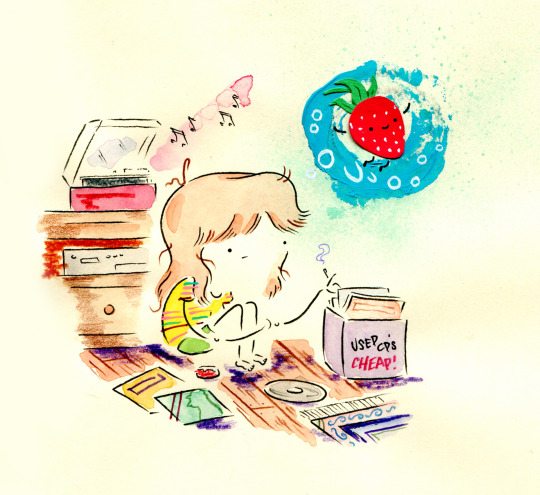Today on the site it's Matt Seneca review Sammy Harkham's Crickets #4.
It’s been about five years since the last issue of Crickets dropped, but one look at the surface of this one and all the giddy anticipation the new issue of a good superhero monthly invokes comes rushing in. Crickets 4 is an easy pick for Harkham’s best cover ever, pulling off the difficult trick of making small figures against a big background pop with ease and grace. The back cover’s even better, a piece of Technicolor randomness that may be the best single page comic of the year. But it’s the guts that count, so in we go: Crickets 4 continues “Blood of the Virgin”, a graphic novel that began serialization in the previous issue -- though if you didn’t know that you wouldn’t be lost for a second, so plainly stated and immediate is the way the story lays itself out. It follows the making of the titular movie, a low-budget ‘70s exploitation thing, and the studio-employed hacks spread thin between making art and making sausage in the process. The main character is Seymour, a slightly schmucky writer angling for more control and better aesthetics, all too aware that his chances for both are slim. Still, even commercial art has to carry some grain of inspiration in it somewhere, and Harkham, a committed acolyte of the kind of movies his story’s about, goes to great lengths to show the real workings of creativity that even the crappiest art project needs to power itself across the finish line. In page after tightly gridded page, we get the nitty-gritty of movie making, well researched and beautifully shown. Moments of individual genius push against the tight rein of the studio bosses; then costs overrun or somebody forgets to show up on set and the real world pulls right back. And in the balance something is born.
Elsewhere:
I can't stand looking for links these days, so instead I present you with another installment of stuff I've been reading. Not as DIY a list as last time (hey kids, send me your comics! I don't ever go to stores or anywhere really besides the playground -- someone could make a lot of money selling "zines", "vinyl records" and cool "lit" books in the parks of Carroll Gardens, Brooklyn), but here goes...
I Hope This Finds You Well
Dan Stafford
Kilgore Books
This is a really lovely collection of Stafford’s “handwritten interviews” project. The interviews run from 2003 through 2014, each providing a decent snapshot of a particular time in each artist’s career. Adrian Tomine is still in Berkeley. It’s 2003 for Crumb, not yet grand-old-man time; Peter Bagge is just beginning his Sanger book. Stafford’s form letter style questions level the playing field so somehow Ian MacKaye and Jeffrey Brown exhibit the same amount of energy, for better or worse.
Blubber
Gilbert Hernandez
Fantagraphics
Gilbert is the cartoonist most deserving of a MacArthur Genius Grant and along, with his brother Jaime and Dan Clowes, one of the top three comic book artists working today. And in the midst of publishing a ton of graphic novels he's dropped this comic book containing a handful of riffs on gender, genitalia and money told in the artist’s scat-poetry style featuring various races of monsters. They are master classes in storytelling and psychological depth. Gilbert has become, in a sense, a minimalist -- using spare lines and ample white space to convey feeling. Gilbert’s only equal in this kind of free form mode is Robert Crumb circa early 1968-1974.
A Body Made of Seeing
Sloan
Self-Published
This comic belongs to a sub-genre I’ve been noticing online and at festivals -- the interior identity exploration monologue (long term for a genre, but who’s counting?) that is perhaps influenced by Edie Fake. This comic uses pink and blue forms to explore a very young person struggling with his/her body/gender. The accompanying prose can be a little precious (“I pray there is magic in this sickness”), but I chalk it up to inexperience.
3 Books
Blaise Larmee
2-D Cloud
The new comics “personalities” like Blaise Larmee seek out attention in a way previous generations of cartoonists did not, which has led, in some cases, to the persona overshadowing the work. Here Larmee has attempted to make a book about the persona. This volume contains three bodies of work. It is formatted like a contemporary art theory book published by Berlin-based art publisher Sternberg Press, which is a little like a graphic novel packaged as a New Directions paperback: It telegraphs intent and desperation and courts exactly the kind of criticism that follows. 3 Books purports to tell three stories (and whether they're fiction or non-fiction is irrelevant. They're dull in either case): The first is the story of multiple sexual encounters between a fan and the author; the second a nude Skype session with a fan; the third a catalog of paintings that represented the author’s fictional “big break” in the art world. I guess this is supposed to comment on the power of the male author and be a send-up of the “the art world” or something, but it’s all so silly. The cartooning is mediocre photo-based drawing. The conceit of Larmee’s ascent in contemporary art is poorly sourced-- he goes on a bender at the Chateau Marmont! He sells all his paintings! He’s been blacklisted from galleries! The paintings look like Jerry Moriarty paintings! If you’re going to satirize comics and art expectations via format and content you have to get the details right. Here Larmee comes off like a message board troll -- raving about things and exhibiting no real knowledge, but giving off enough of an air of authority that people in the basement fest subculture of comics might just believe him. Lowest common denominator "smart" culture.






